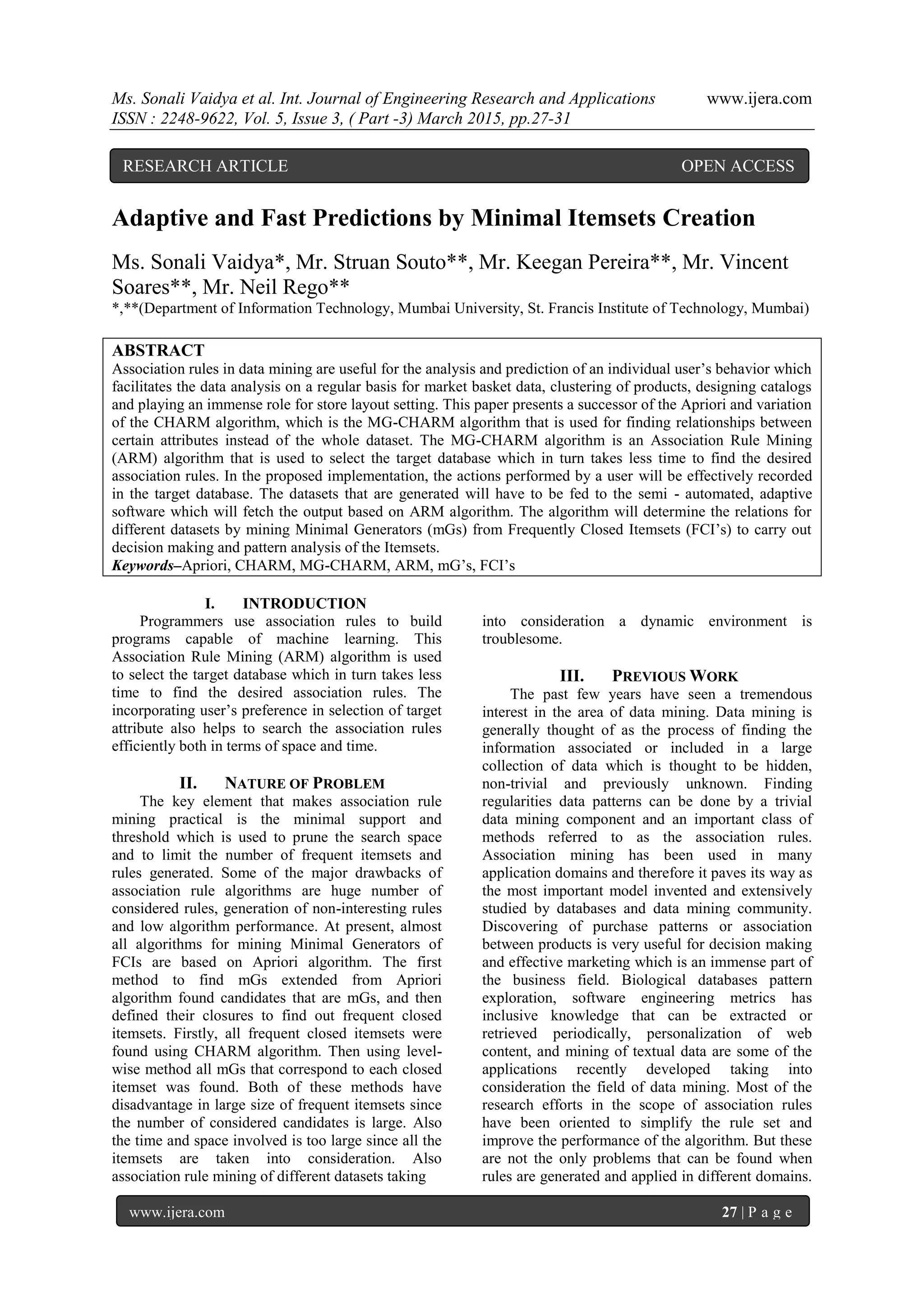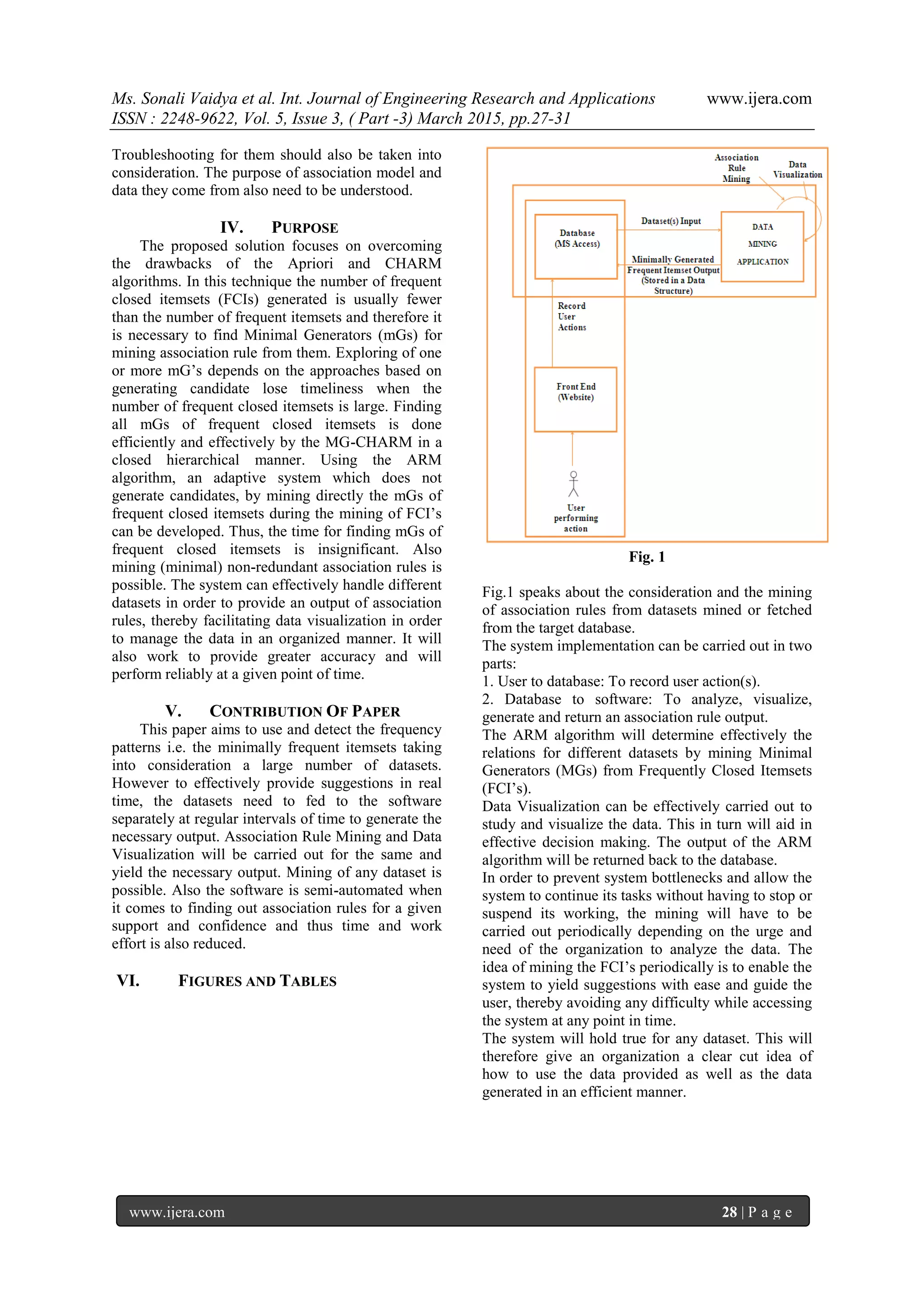This paper presents the MG-CHARM algorithm for mining association rules from transactional datasets. MG-CHARM aims to improve upon the Apriori and CHARM algorithms by mining only the minimal generators of frequent closed itemsets, rather than all frequent itemsets, resulting in faster performance. The algorithm works by first identifying frequent closed itemsets that satisfy a minimum support threshold, then mining just the minimal generators of those closed itemsets to derive association rules. An experimental evaluation shows MG-CHARM performs faster and uses less memory than Apriori and CHARM for the same datasets.


![Ms. Sonali Vaidya et al. Int. Journal of Engineering Research and Applications www.ijera.com
ISSN : 2248-9622, Vol. 5, Issue 3, ( Part -3) March 2015, pp.27-31
www.ijera.com 29 | P a g e
Fig. 2
Fig.2 represents a flow chart of the system in which
a determined support and confidence will give the
required output for a recorded user action provided
the details of the user activity for example: A user
transaction for certain items at a store, is recorded in
the database. The itemset relation is obtained by
pruning which is immensely important and saves
time and memory.
VII. THE ALGORITHM
Input: The database D and support threshold
minSup
Output: all FCI satisfy minSup and their mG
Method:
MG-CHARM(D, minSup)
[Φ]={lj× t(li) ,(Ii): Ii ∈I/ σ (li) ≥minSup}
MG-CHARM-EXTEND([Φ], C = Φ )
Return C
MG-CHARM-EXTEND([P], C)
for each li × t(lj), mG(li) in [P] do
Pi= Pi ∪ li and [Pi]=Φ
for each lj× t(lj), mG(lj) in [P], with j > i do
X = lj and Y=t(li) ∩ t(lj)
MG-CHARM-PROPERTY(X ×Y,li,lj,Pi, [Pi],[Pj)
SUBSUMPTION-CHECK(C, Pi)
MG-CIIARM-EXTEND([Pi],C)
MG-CHARM-PROPERTY(X ×Y,li,lj,Pi, [Pi],[Pj)
ifσ (X) ≥minSup then
if t(li) = t(lj) then // property I
Remove lj from P
Pi=Pi ∪lj
mG(Pi) = mG(Pi) + mG(lj)
else if t(li) ⊂ t(lj) then // property 2
Pi=Pi ∪lj
else if t(li) ⊂ t(lj) then // property 3
Remove Ij from [P]
Add X ×Y,mG(Ij) to [Pi]
else if t(li) ≠ t(1j) then // property 4
Add X ×Y ,∪ [mG(li), mG(lj)]to [Pi]
The MG-CHARM(D, minSup) function takes in
input Database D and the minimum support
necessary for the item sets . [Φ]- denotes the set of
all Item-Transaction pair having minimum support
The MG-CHARM-EXTEND([P], C) function is is
Recursive function until all possible mG’s are
generated. This function calls the MG-CHARM-
PROPERTY(XXY,li,lj,Pi, [Pi],[Pj])
Function where it states that
If t(Xi) = t(Xj) then c(Xi) = c(Xj) = c(Xi∪Xj).
If t(Xi) ⊂ t(Xj) then c(Xi) ≠ c(Xj) but c(Xi) =
c(Xi∪Xj).
If t(Xi) ⊃ t(Xj) then c(Xi) ≠ c(Xj) but c(Xj) =
c(Xi∪Xj).
lf t(Xi) ⊄ t(Xj) and t(Xj) ⊄ t(Xi) then c(Xi) ≠ c(Xj)
≠ c(Xi∪Xj).
The SUBSUMPTION-CHECK function checks
whether frequent itemset Pi is closed or not. If it is,
add it into C, otherwise it will be removed and its
mGs ,will be added to its parent closed. It uses hash-
table to store C, therefore the time of checking is
insignificant.
∪ [mG(li), mG(lj)] are minimal generators of Xi
∪Xj.
The algorithm stated in [11] has been used for the
effective implementation of the adaptive system in
data mining to predict and analyze the output as per
requirement
VIII. EXPERIMENTAL RESULTS AND
COMPARISONS
The experiment has been performed on a JAVA
Swing application coded on a Windows 7 OS, CPU:
2.93 GHz, 2 GB RAM
Let I = {i1, i2, …, in} be a set of items, T = {t1, t2,
…, tm} be a set of transaction identifiers (tids or
tidset) in a database D. The input database is a
binary relation I T. If an item i occurs in a
transaction t, we write it as (i,t) or it.
Consider the following transaction database
Transaction Items Bought
1 1 3 4
2 2 3 5
3 1 2 3 5
4 2 5
5 1 2 3 5
Table 1](https://image.slidesharecdn.com/e503032731-150324011844-conversion-gate01/75/Adaptive-and-Fast-Predictions-by-Minimal-Itemsets-Creation-3-2048.jpg)
![Ms. Sonali Vaidya et al. Int. Journal of Engineering Research and Applications www.ijera.com
ISSN : 2248-9622, Vol. 5, Issue 3, ( Part -3) March 2015, pp.27-31
www.ijera.com 30 | P a g e
For the given transaction database the assumed
support is 50 % and confidence is 50 %. The
association rules generated for the assumption is
shown in Table 2:
Table 2
The results in Table 2 show a mere comparison of
the association rule mining algorithms in terms of
total time required for mining rules, total memory
required and the number of association rules
generated. MG-CHARM is faster than CHARM
which in turn is faster than the traditional Apriori
algorithm. The time required for mining FCI’s and
mining association from the FCI’s is sufficiently less
in case of MG-CHARM which makes it faster than
the prior algorithms. Also the space required is less
for the same datasets considered and for the assumed
support and confidence. Mining of non-redundant
association rules is also possible using the MG-
CHARM algorithm which facilitates generation of
non-redundant queries.
IX. RELATED WORK
3.1 In [10] the proposed method for mining mG’s of
FCI’s needs not generate candidates. Experiments
showed that the time of updating mG’s of frequent
closed itemsets is insignificant. Especially, in case of
the large size of closed itemsets, the time of updating
is very fewer. Some applications of mGs in mining
non-redundant association rules (NARs) based on
methods presented in [3,5].
3.2 Method of Bastide et al
In this section, we present a method for mining
minimal NARs (MINARs) based on FCI’s (Bastide
et al [3]). Assume we had all FCI’s from database D
satisfy minSup. Now, we want to mine MINARs. As
we mentioned above, MINARs only generate from
X →Y, where X is a minimal generator and Y is a
FCI. Bastide et al divided mining MINARs problem
into two sub-problems. Mining MINARs with the
confidence = 100% and mining MINARs with the
confidence < 100%.
Phase 1: Mining MINARs with the confidence =
100% for all g belongs to E mG's (in ascending
length), if g →y(g) then generate the rule { g →y(g)
g} (y(g) is closure of g).
Phase 2: Mining MINARs with the confidence <
100% for k = 1 to µ-1 do // µ is longest FCI’s for all
g belong to mG’s with |g| = k do generate rules from
g →Y g, where g is a subset of Y and Y is a FCI
(Y is not equal to (g)).
3.3 METHOD OF ZAKI
Zaki [5] mined the two kinds of rules. i) Rules with
the confidence = 100%: Self-rules (the rules that
generating from mG’s(X) to X, where X is a FCI)
and Down-rules (the rules that generating from
mG’s(Y) to mG’s(X), where X, Y are FCI’s, X is a
subset of Y). ii) Rules with the confidence < 100%:
From mG’s(X) to mG’s(Y), where X, Y belongs to
FCI’s, X is a subset of Y. Number of rules was
generated by this approach is linear with FCI’s.
X. CONCLUSION
In this paper, the presented MG-CHARM
algorithm is used for mining minimal generators of
frequent closed itemsets. By mere comparisons,
experimental study, and paper research, the
bottleneck identified with the CHARM algorithm is
that the number of frequent items is large and it
takes more time. To solve this problem the numbers
of items were decreased the iterations and new
comparison methodologies were used by enhancing
CHARM. The implementation proposed defines a
generic basis for exact association rules and
transitive reduction of the informative basis for
approximate association rules, non-redundant in
nature and does not represent any loss of information
from the user’s point of view. Visualization and
analysis of the association rules is possible.
Altogether the intended system can be made to work
and function in a dynamic environment. The project
has future scope when very large numbers of
datasets need to be taken into consideration. The
software will be fruitful and show effective
performance when used with a Big Data Database.
Providing suggestions to the user on the basis of a
dynamic scenario will be put into effect in the future.
Acknowledgements
We hereby take the privilege to present our project
report on “Adaptive and Fast Predictions by
Minimal Itemsets Creation”. We are very grateful](https://image.slidesharecdn.com/e503032731-150324011844-conversion-gate01/75/Adaptive-and-Fast-Predictions-by-Minimal-Itemsets-Creation-4-2048.jpg)
![Ms. Sonali Vaidya et al. Int. Journal of Engineering Research and Applications www.ijera.com
ISSN : 2248-9622, Vol. 5, Issue 3, ( Part -3) March 2015, pp.27-31
www.ijera.com 31 | P a g e
to our Project Supervisor Ms. Sonali Vaidya for
contributing her valuable moments in the Project
from her busy and hectic schedule right from the
Project’s inception. Being after us like a true mentor
and a great academic parent.
We are very thankful to Ms. Sonali Vaidya whose
guidance and support was an immense motivation
for us to carry on with our Project. She has been a
constant source of inspiration to us. Her suggestions
have greatly contributed for the betterment of our
project.
Our special thanks to the Head of Department Mr.
Pramod Shanbhag, staff members and lab
assistants for their co-operation.
REFERENCES
[1] R. Agrawal, R. Srikant: Fast algorithms for
mining association rules. In: VLDB'94,
pp(1994).
[2] R. Agrawal, T. Imielinski, A. Swami: Mining
association rules between sets of items in large
databases. In: SIGMOD'93, pp. 207 - 216
(1993).
[3] Y. Bastide, N. Pasquier, R. Taouil, G. Stumme,
L.Lakhal: Mining Minimal Non-Redundant
Association Rules using Closed Frequent
Itemssets. In: 1st International Conference on
Computational Logic, pp. 972 - 986 (2000).
[4] M. 1. Zaki, C.J. Hsiao: Efficient Algorithms for
Mining Closed Itemsets and Their Lattice
Structure. In: IEEE Transactions on
Knowledge and Data Engineering, Vol. 17, No
4, April 2005, pp. 462-478 (2005).
[5] M. 1. Zaki: Mining Non-Redundant
Association Rules, Data Mining and
Knowledge Discovery, 9, 223-248, 2004
Kluwer Academic Publishers. Manufactured in
The Netherlands, pp. 223-248 (2004).
[6] M. J. Zaki, K. Gouda: Fast Vertical Mining
Using Diffsets. In: Proc. Ninth ACM SIGKDD
Int'l Conf.Knowledge Discovery and Data
Mining, pp. 326 335 (2003).
[7] M. J. Zaki, B. Phoophakdee: MIRAGE: A
Framework for Mining, Exploring, and
Visualizing Minimal Association Rules. In:
Technical Report 03-4, Computer Science
Dept., Rensselaer Polytechnic Inst., July
(2003).
[8] M. J. Zaki: Generating Non-Redundant
Association Rules. In: 6th ACM SIGKDD Intl
Conf. Knowledge Discovery and Data Mining,
(2000).
[9] S. B. Yahia, T. Hamrouni, E. M. Nguifo:
Frequent Closed Itemset based Algorithms: A
thorough Structural and Analytical Survey. In:
ACM SIGKDD Explorations Newsletter 8 (1),
pp. 93 - 104 (2006).
[10]Bay Vo, Bac Le: Fast Algorithm for Mining
Minimal Generators of Frequent Closed
Itemsets and Their Applications: A thorough
Structural and Analytical Survey. year-2009.](https://image.slidesharecdn.com/e503032731-150324011844-conversion-gate01/75/Adaptive-and-Fast-Predictions-by-Minimal-Itemsets-Creation-5-2048.jpg)